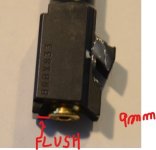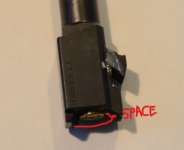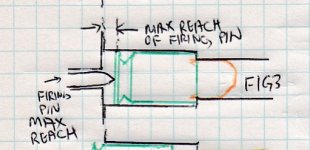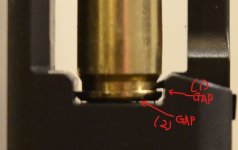380 fit in 9mm chamber of Glock 26
OK, here are more telling pictures. I decided to take a 380 round and put it in the barrel of my Glock 26. Here are the pictures:
1) This is a 9mm round fit into the Glock chamber. Notice the back of the round is flushed with the top part of the barrel as indicated. This is the breech surface line.

2) This is a 380 fit into the Glock chamber. Notice the round sunk into the chamber, there's a min of 1/8" gap from the top of the barrel which represents the breech surface. There is no way the firing pin can reach the primmer without the help of the extractor.

If you have a 10mm, take the barrel out and put a .40S&W round in. There will be no debate if it is like what I see here.
BTW, I am having a hell of the time putting the Gold Cup back!!! I forgot how to take it apart, I had to watch youtube to figure it out. Now the plastic cushion on the main spring is coming apart after 30 something years. Now I have to go buy it. I still have not succeed in putting it back together!!!

OK, here are more telling pictures. I decided to take a 380 round and put it in the barrel of my Glock 26. Here are the pictures:
1) This is a 9mm round fit into the Glock chamber. Notice the back of the round is flushed with the top part of the barrel as indicated. This is the breech surface line.
2) This is a 380 fit into the Glock chamber. Notice the round sunk into the chamber, there's a min of 1/8" gap from the top of the barrel which represents the breech surface. There is no way the firing pin can reach the primmer without the help of the extractor.
If you have a 10mm, take the barrel out and put a .40S&W round in. There will be no debate if it is like what I see here.
BTW, I am having a hell of the time putting the Gold Cup back!!! I forgot how to take it apart, I had to watch youtube to figure it out. Now the plastic cushion on the main spring is coming apart after 30 something years. Now I have to go buy it. I still have not succeed in putting it back together!!!
Attachments
Last edited:




